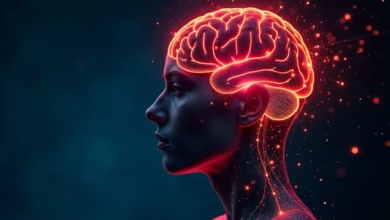AI in Mental Health: Can Technology Heal the Mind?

The blog post AI in Mental Health: Can Technology Heal the Mind? explores the transformative impact of AI mental health solutions in the realm of psychological care. It highlights revolutionary approaches to treatment, including therapy bots that provide support and resources to those in need. The article discusses the benefits of mental health apps, such as increased accessibility and personalized care, while also addressing potential drawbacks, like privacy concerns and reliance on technology over human interaction. Lastly, it offers practical advice on how to effectively utilize digital psychiatry, encouraging readers to embrace AI mental health tools in a balanced manner. Overall, the article showcases how AI can reshape mental health support, helping to make therapeutic resources more available to a wider audience.
The Impact Of AI In Mental Health: A Revolutionary Approach

The emergence of AI in mental health represents a groundbreaking shift in how we approach psychological well-being. By leveraging advanced algorithms and machine learning techniques, digital psychiatry can facilitate personalized treatment plans, enhancing patient engagement and outcomes. With AI-powered tools, mental health professionals can analyze vast amounts of data quickly, ensuring timely interventions that address the unique needs of each patient. This innovative technology not only improves access to care but also fosters a more comprehensive understanding of mental health issues.
Key Aspects of AI in Mental Health
- Personalized treatment options based on patient data
- Enhanced accessibility for individuals in remote areas
- Real-time monitoring of mental health symptoms
- Integration with mobile apps for continuous support
- Data-driven insights to inform therapeutic approaches
- Increased efficiency for mental health professionals
- Potential for destigmatizing mental health care through technology
As we delve deeper into the realm of digital psychiatry, it’s essential to recognize the potential challenges that come along with these advancements. Ethical considerations and privacy concerns need careful navigation to assure patients that their sensitive information remains protected. Furthermore, while AI tools can support mental health professionals, they are not intended to replace human interaction. The interplay between technology and the human touch is crucial for effective treatment, ensuring that patients feel understood and supported throughout their healing journey.
Exploring Therapy Bots And Their Role In AI Mental Health

In recent years, the integration of technology in mental health has given rise to therapy bots, which leverage emotion AI to facilitate mental wellness support. These virtual assistants mimic human interaction while offering a level of accessibility and anonymity that traditional counseling may not provide. By utilizing complex algorithms, therapy bots can analyze text and tone to better understand and respond to a user’s emotional state, making them vital instruments in the ever-evolving landscape of AI mental health.
While therapy bots present innovative opportunities, they also face significant challenges in implementation. Concerns about privacy, data security, and the ethical implications of replacing human therapists loom large. Moreover, establishing trust with users, who may be skeptical of non-human entities, remains a crucial hurdle. Nonetheless, therapy bots represent a significant leap forward in broadening the reach of mental health care, particularly in underserved areas, where professional support might be limited.
Therapy Bots Overview
| Feature | Benefits | Challenges |
|---|---|---|
| Accessibility | Available 24/7 to users | Lack of human empathy |
| Anonymity | Reduces stigma and encourages usage | Concerns about privacy |
| Cost-effectiveness | More affordable than in-person therapy | Limited scope of human-like understanding |
To effectively leverage therapy bots in the mental health space, organizations must undertake a structured approach. The development and implementation of therapy bots involve multiple stages, from conceptualization to user engagement. Clear guidelines must be established to ensure users benefit from their interaction while maintaining ethical standards.
Steps To Implement Therapy Bots
- Define the goals and target audience for the therapy bot.
- Design a user-friendly interface that encourages engagement.
- Develop the emotional AI algorithms for accurate emotional detection.
- Ensure compliance with data protection regulations.
- Incorporate feedback mechanisms for continuous improvement.
- Provide clear disclaimers regarding the limitations of therapy bots.
- Launch a pilot program to test and refine the therapy bot.
Benefits Of Therapy Bots
One of the most significant benefits of therapy bots is their ability to provide users with immediate support. This advantage is especially crucial for individuals who may not seek traditional therapy due to stigma or access issues. Additionally, therapy bots can engage users in different formats, whether through text, voice, or even visual interfaces, making them highly adaptable to varying user preferences.
Challenges In Implementation
Despite their promise, therapy bots confront various challenges during implementation. Technical limitations occasionally hinder the bot’s ability to interpret complex emotional cues or provide nuanced responses. Moreover, user training is essential to help individuals understand the bot’s capabilities and limitations, ensuring a more effective interaction. Addressing these challenges is critical to fully realizing the potential of therapy bots in the realm of AI mental health.
Benefits And Drawbacks Of Mental Health Apps
Mental health apps represent a significant advancement in the realm of AI mental health, offering users accessible tools to better manage their mental wellbeing. These applications can provide immediate support, helping users to track their moods, access resources, and even engage in therapy sessions through their smartphones. However, while these apps can facilitate a level of convenience and resource availability, they also come with certain drawbacks that warrant careful consideration. The efficacy of mental health apps varies, and they should not replace conventional treatment but could serve as a supplementary resource.
Popular Features of Mental Health Apps
- Guided meditation and mindfulness exercises
- Mood tracking tools and journaling features
- Access to licensed therapists through chat or video calls
- Personalized self-help resources and coping strategies
- Community forums for peer support
- Reminder systems for medication and self-care routines
- Educational content about mental health topics
While the integration of technology in mental healthcare comes with numerous benefits, it’s essential to remain aware of potential drawbacks. For instance, individuals relying solely on mental health apps may find a lack of personalized feedback compared to in-person therapy. Additionally, the risk of data privacy concerns looms large in the digital space. In cases where users are sharing sensitive information, transparency about data use is crucial. Therefore, it’s important for individuals to use these apps in conjunction with traditional methods and to remain informed about the extent of their limitations.
Mental health apps provide wonderful tools for self-care but should complement, rather than replace, traditional mental health support systems.
How To Utilize Digital Psychiatry Effectively

To harness the potential of digital psychiatry, it’s essential to establish a structured approach. This involves understanding the available tools and technologies while making informed decisions regarding their implementation. By integrating AI mental health solutions, practitioners can offer personalized care that is both efficient and effective. Utilizing data-driven insights from emotion AI can further enable providers to tailor their treatment plans, ensuring they resonate with the unique needs of each patient.
Actionable Steps For Effective Digital Psychiatry
- Identify your objectives: Clearly outline what you want to achieve with digital psychiatry tools.
- Choose the right platforms: Research and select the most effective mental health apps and AI technologies that align with your goals.
- Train your team: Ensure that all staff members are knowledgeable in utilizing digital tools for patient care.
- Monitor patient data: Continuously assess patient interactions with digital psychiatry solutions to gather insights and improve services.
- Encourage patient engagement: Actively involve patients in their treatment decisions by utilizing interactive digital tools.
- Evaluate results regularly: Plan periodic assessments to measure the effectiveness of digital approaches in mental health care.
- Stay updated on advancements: Keep abreast of new developments in AI mental health technologies to enhance your practice.
Implementing these steps can lead to a transformative experience in digital psychiatry. By adopting a structured approach, professionals can leverage AI mental health tools to create a more responsive and tailored care environment. Moreover, as we continue to explore the intersection of technology and mental health, the integration of emotion AI can significantly enhance the understanding of patients’ emotional states, leading to improved therapeutic outcomes.
Artificial intelligence / humanaifuture.com
🎧 Listen to the Podcast
Want to explore this topic in more depth? Listen to the full podcast for more insights and expert commentary.
▶️ Play on Google DriveNo sign-up needed — just click and listen.
What are the key benefits of integrating AI into mental health solutions?
The integration of AI offers several significant benefits:
- Personalized Treatment Options: AI can analyze patient data to create highly individualized treatment plans.
- Enhanced Accessibility: It makes mental health care more accessible, particularly for individuals in remote areas or those facing barriers to traditional therapy.
- Real-time Monitoring: AI tools can continuously monitor mental health symptoms.
- Continuous Support: Integration with mobile apps provides ongoing support.
- Data-driven Insights: AI provides valuable insights to inform therapeutic approaches and increase efficiency for professionals.
- Destigmatization: Technology can help to destigmatize mental health care by offering anonymous and accessible options.
How do therapy bots contribute to AI mental health, and what are their limitations?
Therapy bots are virtual assistants that utilize "emotion AI" to provide mental wellness support. They mimic human interaction, offering 24/7 accessibility and a level of anonymity that can reduce stigma and encourage usage. These bots analyze text and tone to understand and respond to users' emotional states.
However, therapy bots face significant challenges. They lack human empathy and a limited scope of human-like understanding, which can hinder their ability to interpret complex emotional cues or provide nuanced responses. Concerns about privacy, data security, ethical implications of replacing human therapists, and establishing user trust are also significant hurdles. It is crucial for users to understand the bot's capabilities and limitations.
What are mental health apps, and what are their primary advantages and disadvantages?
Mental health apps are applications that offer accessible tools for managing mental well-being, often integrated with AI mental health functionalities. They provide immediate support, allowing users to track moods, access resources, and even engage in therapy sessions. Popular features include guided meditation, mood tracking, access to licensed therapists via chat/video, personalized self-help resources, community forums, and medication reminders.
While convenient and resourceful, their efficacy varies. A significant drawback is the potential lack of personalized feedback compared to in-person therapy. Additionally, data privacy concerns are prominent, requiring transparency about how sensitive user information is handled. These apps are intended to complement, not replace, traditional mental health support systems.
What ethical considerations and challenges are associated with AI in mental health?
The advancements in digital psychiatry come with significant ethical considerations and challenges. Protecting sensitive patient information is paramount, requiring careful navigation of privacy concerns and data security. A crucial challenge is ensuring that AI tools support mental health professionals rather than replacing human interaction, as the human touch remains essential for effective treatment and fostering a sense of understanding and support. Establishing user trust with non-human entities, especially therapy bots, is also a key hurdle.
Why is the combination of technology and human interaction crucial for effective mental health treatment?
While AI tools offer numerous benefits like personalized care, accessibility, and data-driven insights, they are not intended to replace human interaction in mental health treatment. The interplay between technology and the human touch is crucial for effective treatment because human therapists provide empathy, nuanced understanding, and the ability to build trust and rapport, which are vital for a patient's healing journey. Technology can enhance and support professional care, but it cannot fully replicate the depth of human connection and understanding.
How can individuals and professionals effectively utilize digital psychiatry?
To effectively utilize digital psychiatry and harness its potential, a structured approach is essential. Key steps include:
- Defining Objectives: Clearly outlining goals for using digital tools.
- Choosing Right Platforms: Researching and selecting effective apps and AI technologies that align with goals.
- Training Staff: Ensuring professionals are knowledgeable in using digital tools.
- Monitoring Data: Continuously assessing patient interactions to gather insights.
- Encouraging Engagement: Actively involving patients through interactive digital tools.
- Evaluating Results: Regularly assessing the effectiveness of digital approaches.
- Staying Updated: Keeping abreast of new advancements in AI mental health technologies.
This structured approach allows professionals to leverage AI mental health tools to create a more responsive and tailored care environment.
What is "emotion AI" and its significance in mental health technology?
"Emotion AI" refers to the technology used by tools like therapy bots to analyze text, tone, and potentially other cues to understand and respond to a user's emotional state. By leveraging complex algorithms, emotion AI enables virtual assistants to mimic human interaction more effectively and provide support tailored to a user's specific emotional needs. Its significance lies in its ability to enhance the understanding of patients' emotional states within digital psychiatry, leading to improved therapeutic outcomes and making AI mental health solutions more empathetic and effective.




